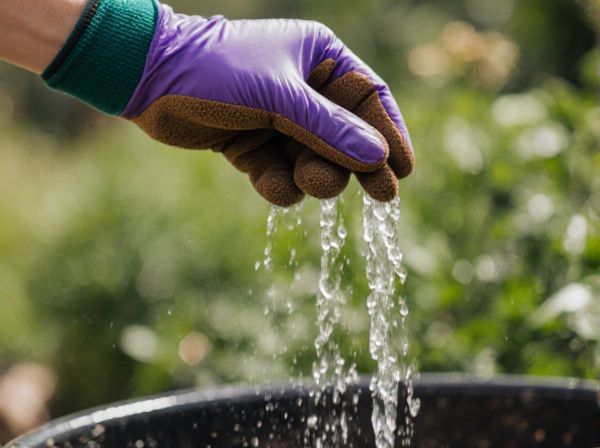
Hand watering vs sprinkler system Illustration
Hand watering allows precise control over the amount and location of water applied, reducing waste and promoting healthier plant growth, especially for delicate or newly planted areas. Sprinkler systems offer convenience and time efficiency by evenly distributing water across larger landscapes, making them ideal for lawns and extensive garden beds. Choosing between the two depends on garden size, plant types, and the need for water conservation.
Table of Comparison
| Feature | Hand Watering | Sprinkler System |
|---|---|---|
| Water Efficiency | Moderate; depends on user control | High; programmable and targeted |
| Time Required | High; manual effort needed | Low; automated schedules |
| Cost | Low; minimal equipment | High; installation and maintenance |
| Coverage Area | Small to medium | Large and uniform |
| Water Distribution | Uneven; user dependent | Even and controlled |
| Environmental Impact | Low; no energy usage | Moderate; uses electricity |
| Maintenance | Minimal | Regular; system checks required |
Hand Watering vs Sprinkler System: An Overview
Hand watering offers precise control over water application, minimizing waste and targeting specific plants, which is ideal for small gardens or container plants. Sprinkler systems provide uniform coverage over larger areas, reducing labor but often leading to higher water consumption and potential runoff. Choosing between hand watering and sprinklers depends on garden size, plant type, and water efficiency goals.
Water Efficiency: Which Method Saves More?
Hand watering allows precise control over water application directly to plant roots, minimizing wastage and runoff, making it highly efficient for small gardens or container plants. Sprinkler systems cover larger areas uniformly but often result in water loss due to evaporation, wind drift, and overspray, reducing overall water efficiency. Choosing hand watering over sprinklers generally saves more water by targeting only the necessary areas, especially when combined with moisture sensors or drip irrigation.
Time and Labor: Manual Effort vs Automation
Hand watering requires significant manual effort and time, making it less efficient for large areas or frequent watering schedules. Sprinkler systems automate the watering process, saving considerable labor and allowing precise control over timing and water distribution. This automation enhances efficiency and frees up time for other gardening tasks.
Plant Health Impact: Personalized Care vs Uniform Coverage
Hand watering allows for precise control of water delivery, ensuring each plant receives the optimal amount for its specific needs, which promotes healthier root development and reduces water stress. Sprinkler systems provide uniform coverage over large areas, but may lead to overwatering or underwatering individual plants due to fixed spray patterns. Personalized watering reduces the risk of fungal diseases and nutrient washout, enhancing overall plant vigor compared to the less targeted approach of sprinkler irrigation.
Cost Analysis: Initial Investment and Ongoing Expenses
Hand watering requires a lower initial investment, typically only needing a hose and nozzle, which can cost between $20 to $50, whereas sprinkler systems often demand a substantial upfront expense ranging from $500 to over $2,500 depending on the system size and complexity. Ongoing expenses for hand watering mainly involve water usage and manual labor time, while sprinkler systems, despite saving labor, incur higher water consumption costs and periodic maintenance fees such as pump repairs and timer replacements. Over time, sprinkler systems may prove cost-effective for large gardens due to automation and evenly distributed watering, whereas hand watering remains economical and practical for smaller areas with minimal water waste.
Flexibility and Control in Garden Watering
Hand watering offers precise control over water distribution, allowing gardeners to target specific plants and adjust the flow based on individual needs. Sprinkler systems provide consistent coverage but may lack the flexibility to water irregularly shaped garden areas or delicate plants without risk of overwatering. Choosing hand watering enhances adaptability for varied plant requirements and minimizes water waste through direct application.
Maintenance Requirements for Each System
Hand watering demands minimal maintenance, primarily involving regular inspection and cleaning of nozzles and hoses to prevent clogging and leaks. Sprinkler systems require more comprehensive upkeep, including seasonal checks of valves, timers, and sprinkler heads to ensure even water distribution and prevent malfunctions. Routine maintenance of each system directly impacts water efficiency and longevity, influencing overall lawn and garden health.
Suitability for Different Garden Types
Hand watering offers precise control ideal for small gardens, container plants, and delicate seedlings, ensuring targeted hydration without water waste. Sprinkler systems provide uniform coverage suited for large lawns and sprawling garden beds, efficiently maintaining consistent moisture levels over broad areas. Choosing between hand watering and sprinklers depends on garden size, plant types, and water conservation needs.
Environmental Considerations and Sustainability
Hand watering uses less water and minimizes runoff, promoting efficient water use in garden irrigation. Sprinkler systems, while convenient, often lead to higher water waste due to evaporation and overwatering. Choosing hand watering supports sustainability efforts by conserving water resources and reducing energy consumption associated with automated systems.
Choosing the Right Watering Method for Your Garden
Hand watering offers precise control over water distribution, making it ideal for small gardens and delicate plants requiring targeted hydration. Sprinkler systems efficiently cover larger areas, saving time and ensuring consistent moisture levels across lawns and extensive flower beds. Consider garden size, plant types, and water conservation goals when selecting the optimal watering method to promote healthy growth and reduce water waste.
Hand watering vs sprinkler system Infographic

 gardendif.com
gardendif.com